|
|
|
Sort Order |
|
|
|
Items / Page
|
|
|
|
|
|
|
| Srl | Item |
| 1 |
ID:
186531
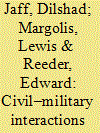

|
|
|
|
|
| Summary/Abstract |
Humanitarian agencies and military forces are increasingly interacting on the ground during humanitarian crises. These evolving relationships are often complicated and bring forward many implementation challenges. This paper repurposes this debate by describing three non-conflict humanitarian case studies and using them to reflect on the problematic history and applicability of formal frameworks and guidelines. Recommendations to improve the structures and processes for implementation of relief strategies are offered. If the delivery of humanitarian assistance during non-conflict humanitarian crises is to be efficient, civil–military interactions should receive greater systematic attention.
|
|
|
|
|
|
|
|
|
|
|
|
|
|
|
|
| 2 |
ID:
116448
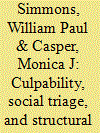

|
|
|
|
|
| Publication |
2012.
|
| Summary/Abstract |
Hurricane Katrina and its effects are often talked about in terms of what has been made visible, as if the hurricane swept through and stripped away our structural blinders along with the levees, revealing social disparities within. Here, we focus instead on whom and what Katrina and its aftermath have rendered invisible. We are concerned with how the seen and the not seen have influenced the ways the purported tabula rasa of New Orleans has been (re)constructed and marked since 2005. We engage with recent debates in political science about power, agency, structure, and culpability, arguing that efforts to prioritize the pursuit of culpability over critique in power analyses, such as the approach advocated by Steven Lukes, risk perpetuating structural violence. We employ the concepts of an ocular ethic and social triage to understand why the storm of the century that was supposed to reveal all has in the end left much concealed, with shocking levels of human devastation unaddressed. Only through careful excavation of the ruins can we begin to comprehend the sedimented inequality and layers of vulnerability that structure violence.
|
|
|
|
|
|
|
|
|
|
|
|
|
|
|
|
| 3 |
ID:
126418
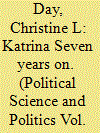

|
|
|
|
|
| Publication |
2013.
|
| Summary/Abstract |
After Hurricane Katrina struck the Gulf Coast in 2005, flooding the city of New Orleans for several weeks after levees collapsed, the city struggled to recover and rebuild. Scholars and activists participating in the roundtable, "Katrina Seven Years On: The Politics of Race and Recovery," at the 2012 APSA Annual Meeting in New Orleans, were to discuss recovery and racial justice in post-Katrina urban planning and rebuilding efforts, grassroots movements, job recovery, fair housing, and cultural revival. Although the 2012 meeting was canceled as Hurricane Isaac threatened New Orleans anew, panelists offered their observations and ideas to be summarized for PS readers.
|
|
|
|
|
|
|
|
|
|
|
|
|
|
|
|
| 4 |
ID:
116447
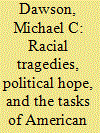

|
|
|
|
|
| Publication |
2012.
|
| Summary/Abstract |
The Trayvon Martin tragedy, the optimistic spectacle of the election and inauguration of Barack Obama during late 2008 and early 2009, and the aftermath of Hurricane Katrina seemingly represent three very different events with little in common except the claim made by some that all were in some way related to racial politics in the US. Many would consider such a claim weak, noting each event's unique scale and relationship to the politics of race in the US. Yet I argue that that the events are in fact closely linked in fundamental ways that are important not only to political scientists, but, more importantly, to all who care about the health of democracy within the US. Each event demonstrates the massive racial cleavages within the US. Each event illustrates the nature of evolving racial order in the US. Each event illustrates the weaknesses and problems that confront contemporary black politics. And each event thus illuminates key questions that should motivate theoretical and empirical work on race and politics within political science. In this essay, I highlight the themes and processes that tie together these seemingly disparate events, some marked by hope, others by despair. I start by analyzing each event from the standpoint of the persistent, if evolving, racial divide in American public opinion. And I end by arguing that scholars of race and politics often have to adhere to the most rigorous scholarly standards while also fulfilling their duties as citizens.
|
|
|
|
|
|
|
|
|
|
|
|
|
|
|
|
| 5 |
ID:
101282
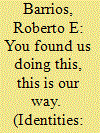

|
|
|
|
|
| Publication |
2010.
|
| Summary/Abstract |
This article analyzes the changing ways law enforcement agencies, city government officials, and gentrifying resident constituencies have attempted to criminalize and surveil disposition-forming rituals and daily social practices of African American working class New Orleanians before and after Hurricane Katrina. The rituals and practices discussed include pedestrian parades known as Second Lines and Super Sunday. The article demonstrates that the criminalization and surveillance of these practices must be understood in light of the role played by socially structured space in the production of racialized class differences among New Orleanians. In the post-Katrina context, the city's mandatory evacuation enabled gentrifying resident constituencies and expert urban planners to imagine the city's reconstruction as something to be achieved through the creation of architectonic relationships conducive to cycles of capital investment. These visions of urban recovery have ignored the importance residents of affected neighborhoods place on the reinstatement of the city's pre-Katrina population, which is responsible for the production of Second Lines and Super Sunday. This article explores how the policing, surveillance, and criminalization of Second Lines and Super Sunday have historically operated as mechanisms for upholding hegemonic orders, and the intimate connections between planning, race, and gentrification in the US.
|
|
|
|
|
|
|
|
|
|
|
|
|
|
|
|
|
|
|
|
|